Aspects of Digitalization and Related Impact on Green Tourism in European Countries
Abstract
:1. Introduction
2. Literature Review
3. Methodology and Data
- i stands for the country, N = 30 (the sample size);
- represents the value of the explained, response variable for country i;
- represents the value of the explanatory variable j for country i;
- β0, β1,…, βk, are the regression model parameters (β0 is the intercept parameter, while β1 − βk are the slope parameters);
- k is the number of explanatory variables included in the model;
- ɛi represents the value of the residual variable for country i.
4. Analysis of the Relationship between Digitalization and Sustainable Component of Tourism. Main Results
4.1. Analysis of Digitalization’s Influence on Green Tourism
4.2. Identifying the Main Behavior Patterns of European Countries Regarding Digitalization and Tourism
5. Discussion
6. Conclusions
Author Contributions
Funding
Conflicts of Interest
References
- Dinu, M. Geografia Turismului; Didactic and Pedagogical Publishing House: Bucharest, Romania, 2006. [Google Scholar]
- Sevrani, K.; Elmazi, L. ICT and the changing landscape of tourism distribution—A new dimension of tourism in the global condition. Tour. J. 2008, 6, 22–29. [Google Scholar]
- Liburd, J.J. Tourism Research 2.0. Ann. Tour. Res. 2012, 39, 883–907. [Google Scholar] [CrossRef]
- Lange-Faria, W.; Elliot, S. Understanding the role of social media in destination marketing. Tourismos 2012, 7, 193–211. [Google Scholar]
- Lambert, J.; Nieuwenhuis, M.L.; Ehrenhard, L.P. The shift to Cloud Computing: The impact of disruptive technology on the enterprise software business ecosystem. Technol. Forecast. Soc. Change 2018, 129, 308–313. [Google Scholar]
- Tohanean, D.; Toma, S.G.; Dumitru, I. Organizational Performance and Digitalization in Industry 4.0. J. Emerg. Trends Mark. Manag. 2018, 1, 282–293. [Google Scholar]
- Tohanean, D.; Buzatu, A.I.; Baba, A.; Georgescu, B. Business Model Innovation Through the Use of Digital Technologies: Managing Risks and Creating Sustainability. Amfiteatru Econ. 2020, 22, 758–774. [Google Scholar]
- Sahut, J.M.; Peris-Ortiz, M. Small business, innovation, and entrepreneurship. Small Bus. Econ. 2014, 42, 663–668. [Google Scholar] [CrossRef]
- Margherita, A.; Petti, C. E-Business Adoption. A Readiness and Process Study of the Italian Tourism Distribution. Int. J. E-Bus. Manag. 2009, 3, 3–19. [Google Scholar] [CrossRef]
- Koukopoulos, D.; Styliaras, G. Design of trustworthy smartphonebased multimedia services in cultural environment. Electron. Commer. Res. 2013, 13, 129–150. [Google Scholar] [CrossRef]
- Huang, T.; Lee, T.J.; Lee, K.H. Innovative e-commerce model for food tourism product. Int. J. Tour. Res. 2009, 11, 595–600. [Google Scholar] [CrossRef]
- Souto, J.E. Business model innovation and business concept innovation as the context of incremental innovation and radical innovation. Tour. Manag. 2015, 51, 142–155. [Google Scholar] [CrossRef]
- Rusu, B. The Impact of Innovations on the Business Model: Exploratory Analysis of a Small Travel Agency. Procedia Soc. Behav. Sci. 2016, 221, 166–175. [Google Scholar] [CrossRef] [Green Version]
- Williams, A.M.; Shaw, G. Internationalization and innovation in tourism. Ann. Tour. Res. 2011, 38, 27–51. [Google Scholar] [CrossRef] [Green Version]
- Bigné, E.; Decrop, A. Paradoxes of Postmodern Tourists and Innovation in Tourism Marketing. In The Future of Tourism; Fayos-Solà, E., Cooper, C., Eds.; Springer: Cham, Switzerland, 2019; pp. 131–154. [Google Scholar]
- Dredge, D.; Phi, G.; Mahadevan, R.; Meehan, E.; Popescu, E.S. Digitalization in Tourism: In-Depth Analysis of Challenges and Opportunitie Low Value Procedure GRO-SME-17-C-091-A for Executive Agency for Small and Medium-Sized Enterprises (EASME) Virtual Tourism Observatory; Aalborg University: Copenhagen, Demark, 2018. [Google Scholar]
- Liu, Y.Y.; Mačerinskienė, A. Managing the Digital Campaign Process for Sustainable Tourism Destination. WIT Trans. Ecol. Environ. 2016, 201, 139–153. [Google Scholar]
- Furqan, A.; Mat, S.; Ahmad, P.; Hussin, R. Promoting Green tourism for future sustainability. Theor. Empir. Res. Urban. Manag. 2010, 5, 64–74. [Google Scholar]
- Budeanu, A. Sustainable tourist behavior—A discussion of opportunities for change. Int. J. Consum. Stud. 2007, 31, 499–508. [Google Scholar] [CrossRef]
- Baldassarre, B.; Calabretta, G.; Bocken, N.M.P.; Jaskiewicz, T. Bridging sustainable business model innovation and user-driven innovation: A process for sustainable value proposition design. J. Clean Prod. 2017, 147, 175–186. [Google Scholar] [CrossRef] [Green Version]
- Eurostat. Tourism in the EU—What a Normal Summer Season Looks Like—Before Covid-19. 2020. Available online: https://ec.europa.eu/eurostat/statistics-explained/index.php?title=Tourism_in_the_EU_-_what_a_normal_summer_season_looks_like_-_before_Covid-19 (accessed on 15 July 2020).
- Reinhold, S.; Zach, F.J.; Krizaj, D. Business models in tourism: A review and research agenda. Tour. Rev. 2017, 72, 462–482. [Google Scholar] [CrossRef]
- UNWTO. EU Guidebook on Sustainable Tourism for Development. 2020. Available online: https://www.unwtorg/EU-guidebook-on-sustainable-tourism-for-development (accessed on 8 August 2020).
- Pintassilgo, P. Green Tourism. In Encyclopedia of Tourism; Jafari, J., Xiao, H., Eds.; Springer: Cham, Switzerland, 2016; Chapter 264. [Google Scholar]
- Marin-Pantelescu, A.; Tachiciu, L.; Capusneanu, S.; Topor, D.I. Role of Tour Operators and Travel Agencies in Promoting Sustainable Tourism. Amfiteatru Econ. 2019, 21, 654–669. [Google Scholar] [CrossRef]
- Leonidou, L.; Leonidou, N.; Fotiadis, T.A.; Zeriti, A. Resources and capabilities as drivers of hotel environmental marketing strategy: Implications for competitive advantage and performance. Tour. Manag. 2013, 35, 94–110. [Google Scholar] [CrossRef]
- Han, H.; Hsu, L.J.; Lee, J.S.; Sheu, C. Are lodging customers ready to go green? An examination of attitudes, demographics, and eco-friendly intention. Int. J. Hosp. Manag. 2011, 30, 345–355. [Google Scholar] [CrossRef]
- Knowles, T.; Macmillan, S.; Palmer, J.; Grabowski, P.; Hashimoto, A. The development of environmental initiatives in tourism: Responses from the London hotel sector. Int. J. Tour. Res. 1999, 1, 255–265. [Google Scholar] [CrossRef]
- The Global Sustainable Tourism Council. GSTC Industry Criteria. 2016. Available online: https://www.gstcouncil.org/gstc-criteria/ (accessed on 10 August 2020).
- Niñerola, A.; Sánchez-Rebull, M.-V.; Hernández-Lara, A.-B. Tourism Research on Sustainability: A Bibliometric Analysi. Sustainability 2019, 11, 1377. [Google Scholar] [CrossRef] [Green Version]
- Wall, G. Is Ecotourism Sustainable? Environ. Manag. 1997, 21, 483–491. [Google Scholar] [CrossRef] [PubMed]
- Buckley, R. Sustainable Tourism: Research and Reality. Ann. Tour. Res. 2012, 39, 528–546. [Google Scholar] [CrossRef] [Green Version]
- Zolfani, S.H.; Sedaghat, M.; Maknoon, R.; Zavadskas, E.K. Sustainable Tourism: A Comprehensive Literature Review on Frameworks and Application. Econ. Res. 2015, 28, 1–30. [Google Scholar]
- Tosun, C. Challenges of Sustainable Tourism Development in the Developing World: The Case of Turkey. Tour. Manag. 2001, 22, 289–303. [Google Scholar] [CrossRef]
- Harrison, L.; Jayawardena, C.; Clayton, A. Sustainable Tourism Development in the Caribbean: Practical Challenge. Int. J. Contemp. Hosp. Manag. 2003, 15, 294–298. [Google Scholar] [CrossRef]
- Mbaiwa, J.E. The Problems and Prospects of Sustainable Tourism Development in the Okavango Delta, Botswana. J. Sustain. Tour. 2005, 13, 203–227. [Google Scholar] [CrossRef]
- Koutsouris, A. Social Learning and Sustainable Tourism Development; Local Quality Conventions in Tourism: A Greek Case Study. J. Sustain. Tour. 2009, 17, 567–581. [Google Scholar] [CrossRef]
- Castellani, V.; Sala, S. Sustainable Performance Index for Tourism Policy Development. Tour. Manag. 2010, 31, 871–880. [Google Scholar] [CrossRef]
- Turton, S.; Dickson, T.; Hadwen, W.; Jorgensen, B.; Pham, T.; Simmons, D.; Wilson, C. Developing an Approach for Tourism Climate Change Assessment: Evidence from Four Contrasting Australian Case Studie. J. Sustain. Tour. 2010, 18, 429–447. [Google Scholar] [CrossRef] [Green Version]
- Kaján, E.; Saarinen, J. Tourism, Climate Change and Adaptation: A Review. Curr. Issues Tour. 2013, 16, 167–195. [Google Scholar] [CrossRef]
- Garín-Muñoz, T.; Perez, A.T. Internet Usage for Travel and Tourism. The Case of Spain. Tour. Econ. 2010, 17, 1071–1085. [Google Scholar] [CrossRef] [Green Version]
- Huang, R.-Y.; Chang, W.-J.; Chung, Y.-C.; Yin, Y.-S.; Yen, J. A Literature Review of Sustainable Tourism (1990–2016): Development Trajectory and Framework. Int. J. Tour. Res. 2019, 6, 20–49. [Google Scholar]
- Kim, H.; Xiang, Z.; Fesenmaier, D. Use of the Internet for Trip Planning: A Generational Analysi. J. Travel. Tour. Mark. 2015, 32, 276–289. [Google Scholar] [CrossRef]
- Xiang, Z.; Dan, W.; O’Leary, J.; Fesenmaier, D. Adapting to the Internet: Trends in Travelers’ Use of the Web for Trip Planning. J. Travel. Res. 2014, 54, 511–527. [Google Scholar] [CrossRef]
- Vajčnerová, I.; Šácha, J.; Ryglova, K. Using the Principal Component Analysis for Evaluating the Quality of a Tourist Destination. Acta Univ. Agric. et Silvic. Mendelianae Brun. 2012, 60, 449–458. [Google Scholar] [CrossRef] [Green Version]
- Muresan, I.; Oroian, C.; Harun, R.; Arion, F.; Porutiu, A.; Chiciudean, G.; Todea, A.; Lile, R. Local Residents’ Attitude toward Sustainable Rural Tourism Development. Sustainability 2016, 8, 100. [Google Scholar] [CrossRef] [Green Version]
- Falk, M.; Hagsten, E. Ways of the Green Tourist in Europ. J. Clean Prod. 2019, 225, 1033–1043. [Google Scholar] [CrossRef]
- Michailidou, A.V.; Vlachokostas, C.; Moussiopoulos, N. Interactions between Climate Change and the Tourism Sector: Multiple-Criteria Decision Analysis to Assess Mitigation and Adaptation Options in Tourism Area. Tour. Manag. 2016, 55, 1–26. [Google Scholar] [CrossRef]
- White, V.; McCrum, G.; Blackstock, K.L.; Scott, A. Indicators and Sustainable Tourism: Literature Review; The Macaulay Institute: Aberdeen, UK, 2006; Available online: https://citeseerx.ist.psu.edu/viewdoc/download?doi=10.1.1.468.246&rep=rep1&type=pdf (accessed on 20 September 2020).
- Scheepens, A.E.; Vogtländer, J.G.; Brezet, J. Two Life Cycle Assessment (LCA) based Methods to Analyse and Design Complex (Regional) Circular Economy System Case: Making Water Tourism More Sustainable. J. Clean Prod. 2016, 114, 257–268. [Google Scholar] [CrossRef]
- Genovese, D.; Culasso, F.; Giacosa, E.; Battaglini, L.M. Can Livestock Farming and Tourism Coexist in Mountain Regions? A New Business Model for Sustainability. Sustainability 2017, 9, 2021. [Google Scholar]
- Ionescu, G.; Firoiu, D.; Pîrvu, R.; Bădîrcea, R.; Drăgan, C. Implementation of Integrated Management Systems and Corporate Social Responsibility Initiatives—A Romanian Hospitality Industry Perspectiv. Sustainability 2018, 10, 3684. [Google Scholar] [CrossRef] [Green Version]
- Del Vecchio, P.; Mele, G.; Ndou, V.; Secundo, G. Open Innovation and Social Big Data for Sustainability: Evidence from the Tourism Industry. Sustainability 2018, 10, 3215. [Google Scholar] [CrossRef] [Green Version]
- Mihalič, T.; Žabkar, V.; Cvelbar, L.K. A hotel sustainability business model: Evidence from Slovenia. J. Sustain. Tour 2012, 20, 701–719. [Google Scholar]
- Høgevold, N.M.; Svensson, G.; Wagner, B.; Petzer, D.J.; Klopper, H.B.; Varela, J.S.; Padin, C.; Ferro, C. Sustainable business models: Corporate reasons, economic effects, social boundaries, environmental actions and organizational challenges in sustainable business practice. Balt. J. Manag. 2014, 9, 357–380. [Google Scholar] [CrossRef]
- Hudson, S.; Miller, G.A. The responsible marketing of tourism: The case of Canadian mountain holiday. Tour. Manag. 2005, 26, 133–142. [Google Scholar] [CrossRef] [Green Version]
- GhulamRabbany, M.; Afrin, S.; Rahman, A.; Islam, F.; Hoque, F. Environmental Effects of Tourism. Am. Energy Environ. Power Res. 2013, 1, 117–130. [Google Scholar]
- Paramati, S.; Shahbaz, M.; Alam, M.S. Does tourism degrade environmental quality? A comparative study of eastern and Western European Union. Transp. Res. D 2017, 50, 1–13. [Google Scholar]
- Paramati, S.; Alam, M.S.; Chen, F. The effects of tourism on economic growth and CO2 emissions a comparison between developed and developing economie. J. Travel. Res. 2017, 56, 712–724. [Google Scholar] [CrossRef] [Green Version]
- Mikayilov, J.I.; Mukhtarov, S.; Mammadov, J. Correction to: Re-evaluating the environmental impacts of tourism: Does EKC exist? Environ. Sci. Pollut. Res. 2019, 26, 32674. [Google Scholar] [CrossRef] [PubMed] [Green Version]
- Dabija, D.; Bejan, B.; Grant, D. The impact of consumer green behaviour on green loyalty among retailformats: A romanian case study. Morav. Geogr. Rep. 2018, 26, 173–185. [Google Scholar]
- Sheth, J.N.; Sethia, N.K.; Srinivas, S. Mindful consumption: A customer-centric approach to sustainability. J. Acad. Mark. Sci. 2011, 39, 21–39. [Google Scholar] [CrossRef]
- Tölkes, C. Sustainability communication in tourism—A literature review. Tour. Manag. Perspect. 2018, 27, 10–21. [Google Scholar] [CrossRef]
- Verma, D.; Bala, M.A. Critical Review of Digital Marketing. Int. J. Ind. Eng. Manag. Sci. 2018, 8, 321–339. [Google Scholar]
- Andronie, M.; Gârdan, D.A.; Dumitru, I.; Gârdan, I.P.; Andronie, I.E.; Uță, C. Integrating the Principles of Green Marketing by Using Big Data. Good Practice. Amfiteatru Econ. 2019, 21, 258–269. [Google Scholar] [CrossRef]
- Font, X.; McCabe, S. Sustainability and marketing in tourism: Its contexts, paradoxes, approaches, challenges and potential. J. Sustain. Tour. 2017, 25, 869–883. [Google Scholar] [CrossRef] [Green Version]
- Yeh, T.; Chen, S.; Chen, T. The Relationships among Experiential Marketing, Service Innovation, and Customer Satisfaction—A Case Study of Tourism Factories in Taiwan. Sustainability 2019, 11, 1041. [Google Scholar] [CrossRef] [Green Version]
- Jones, P.; Clarke-Hill, C.; Comfort, D.; Hillier, D. Marketing and sustainability. Mark. Intell. Plan. 2008, 26, 123–130. [Google Scholar] [CrossRef]
- Okazaki, S.; Hirose, M. Does gender affect media choice in travel information search? On the use of mobile Internet. Tour. Manag. 2009, 30, 794–804. [Google Scholar] [CrossRef] [Green Version]
- Lai, I.K.W. Travelers’ acceptance of an App-based mobile tour guid. J. Hosp. Tour. Res. 2015, 39, 401–432. [Google Scholar] [CrossRef]
- Guttentag, D.A. Virtual reality: Applications and implications for tourism. Tour. Manag. 2010, 31, 637–651. [Google Scholar] [CrossRef]
- Huang, Y.-C.; Backman, K.F.; Backman, S.J.; Chang, L.L. Exploring the Implications of Virtual Reality Technology in Tourism Marketing: An Integrated Research Framework. Int. J. Tour. Res. 2016, 18, 116–128. [Google Scholar] [CrossRef]
- Murphy, J.; Hofacker, C.; Gretzel, U. Dawning of the age of robots in hospitality and tourism: Challenges for teaching and research. Eur. J. Tour. Res. 2017, 15, 104–111. [Google Scholar]
- Yang, L.; Henthorne, T.L.; Babu, G. Artificial Intelligence and Robotics Technology in the Hospitality Industry: Current Applications and Future Trend Digital Transformation in Business and Society; Palgrave Macmillan: Cham, Germany, 2020; pp. 211–228. [Google Scholar]
- Lee, H.; Cranage, D.A. Personalization—Privacy paradox: The effects of personalization and privacy assurance on customer responses to travel Web site. Tour. Manag. 2011, 32, 987–994. [Google Scholar] [CrossRef]
- Parra-López, E.; Bulchand-Gidumal, J.; Gutiérrez-Taño, D.; Díaz-Armas, C. Intentions to use social media in organizing and taking vacation trip. Comput. Hum. Behav. 2011, 27, 640–654. [Google Scholar] [CrossRef]
- Morosan, C. Theoretical and empirical considerations of guests’ perceptions of biometric systems in hotels: Extending the technology acceptance model. J. Hosp. Tour. Res. 2010, 36, 52–84. [Google Scholar] [CrossRef]
- Ayeh, J.K.; Au, N.; Law, R. Predicting the intention to use consumer-generated media for travel planning. Tour. Manag. 2013, 35, 132–143. [Google Scholar] [CrossRef]
- Disztinger, P.; Schlögl, S.; Growth, A. Technology Acceptance of Virtual Reality for Travel Planning. In Information and Communication Technologies in Tourism; Schegg, C., Stangl, B., Eds.; Springer: Cham, Switzerland, 2017; pp. 255–268. [Google Scholar]
- Ketter, E. Millennial travel: Tourism micro-trends of European Generation, Y. J. Tour. Futures 2020. In Press. [Google Scholar] [CrossRef] [Green Version]
- Kim, D.Y.; Park, S. Rethinking millennials: How are they shaping the tourism industry? Asia Pac. J. Tour. Res. 2020, 25, 1–2. [Google Scholar]
- Arora, H. Ecotourism: Repositioning green tourism amongst millennial generation in India. World Review of Entrepreneurship. Manag. Sustain. Dev. 2018, 14, 747. [Google Scholar]
- Șchiopu, A.F.; Pădurean, A.M.; Țală, M.L.; Nica, A.-M. The Influence of New Technologies on Tourism Consumption Behavior of the Millennial. Amfiteatru Econ. 2016, 18, 829–846. [Google Scholar]
- KPMG. Meet the Millennial 2017. Available online: https://homkpmg/content/dam/kpmg/uk/pdf/2017/04/Meet-the-Millennials-Secured.pdf (accessed on 15 July 2020).
- Moisă, C. Turismul de Tineret-Realităţi şi Perspective; Aeternitas: Alba Iulia, Romania, 2015. [Google Scholar]
- Cavagnaro, E.; Staffieri, S.; Postma, A. Understanding millennials’ tourism experience: Values and meaning to travel as a key for identifying target clusters for youth (sustainable) tourism. J. Tour. Futures 2018, 4, 31–42. [Google Scholar]
- Nielsen. Young and Ready to Travel: A Look at Millennial Traveler 2017. Available online: www.nielsen.com/wp-content/uploads/sites/3/2019/04/nielsen-millennial-traveler-study-jan-2017.pdf (accessed on 15 July 2020).
- Skinner, H.; Sarpong, D.; White, G. Meeting the needs of the Millennials and Generation Z: Gamification in tourism through geocaching. J. Tour. Futures 2018, 4, 93–104. [Google Scholar]
- Deloitt the Deloitte Global Millennial Survey. 2020. Available online: https://www2.deloittcom/global/en/pages/about-deloitte/articles/millennialsurvey.html (accessed on 15 July 2020).
- Passafaro, P.; Cini, F.; Boi, L.; D’Angelo, M.; Heering, M.S.; Luchetti, L.; Mancini, A.; Martemucci, V.; Pacella, G.; Patrizi, F.; et al. The “Sustainable Tourist”: Values, Attitudes, and Personality Trait. Tour. Hosp. Res. 2015, 15, 225–239. [Google Scholar]
- Pulido-Fernández, J.; López-Sánchez, Y. Are Tourists Really Willing to Pay More for Sustainable Destinations? Sustainability 2016, 8, 1240. [Google Scholar]
- UNWTO. Tourism in the Green Economy: Background Report; World Tourism Organization: Madrid, Spain, 2013; Available online: https://www.e-unwtorg/doi/pdf/10.18111/9789284414529 (accessed on 8 August 2020).
- European Commission. Communication from the Commission to the European Parliament, the Council, the European Economic and Social Committee and the Committee of the Region. 2020. Available online: https://eur-lex.europa.eu/legal-content/EN/TXT/HTML/?uri=CELEX:52020DC0550&from=EN (accessed on 15 July 2020).
- EUROSTAT. Available online: https://ec.europa.eu/eurostat/data/database (accessed on 10 September 2020).
- Long, J.; Vogelaar, A.; Hale, B.W. Toward sustainable educational travel. J. Sustain. Tour. 2014, 22, 421–439. [Google Scholar]
- Ghaderi, Z.; Henderson, J. Sustainable rural tourism in Iran: A perspective from Hawraman Villag. Tour. Manag. Perspect. 2012, 2, 47–54. [Google Scholar]
- Mustika, P.L.K.; Birtles, A.; Everingham, Y.; Marsh, H. The human dimensions of wildlife tourism in a developing country: Watching spinner dolphins at Lovina, Bali, Indonesia. J. Sustain. Tour. 2013, 21, 229–251. [Google Scholar]
- Liu, H.S.; Horng, J.S.; Chou, S.F. A critical evaluation of sustainable tourism from the integrated perspective: Conducting moderated-mediation analysi. Tour. Manag. Perspect. 2015, 16, 43–50. [Google Scholar]
- European Parliament. Fact Sheets of the European Union. Tourism. Available online: https://www.europarl.europa.eu/factsheets/en/sheet/126/tourism (accessed on 11 September 2020).
- Houston, K.; Reay, D.S. The impact of information and communication technology on GHG emissions: How green are virtual worlds? Carbon Manag. 2014, 2, 629–643. [Google Scholar] [CrossRef]
- Malmodin, J.; Bergmark, P.; Lovehagen, N.; Ercan, M.; Bondesson, A. Considerations for macro-level studies of ICTas enablement potential. In Proceedings of the 2014 Conference ICT for Sustainability, Stockholm, Sweden, 24–27 August 2014; Atlantis Press, B.V.: Amsterdam, The Netherlands, 2014. [Google Scholar]
- Liu, Y.; Kumail, T.; Ali, W.; Sadiq, F. The dynamic relationship between CO2 emission, international tourism and energy consumption in Pakistan: A cointegration approach. Tour. Rev. 2019, 4, 761–779. [Google Scholar] [CrossRef]
- Bojanic, D.; Warnick, R.B. The Relationship between a Country’s Level of Tourism and Environmental Performanc. J. Travel. Res. 2020, 59, 220–230. [Google Scholar]
- Azam, M.; Alam, M.M.; Hafeez, M.H. Effect of tourism on environmental pollution: Further evidence from Malaysia, Singapore and Thailand. J. Clean. Prod. 2018, 190, 330–338. [Google Scholar]
- Aslan, A.; Altinoz, B.; Özsolak, B. The nexus between economic growth, tourism development, energy consumption, and CO2 emissions in Mediterranean countrie. Environ. Sci. Pollut. Res. 2020, 27, 40930–40948. [Google Scholar]
- Hojeghan, S.B.; Esfangareh, A.N. Digital economy and tourism impacts, influences and challenge. Procedia Soc. Behav. Sci. 2011, 19, 308–316. [Google Scholar]
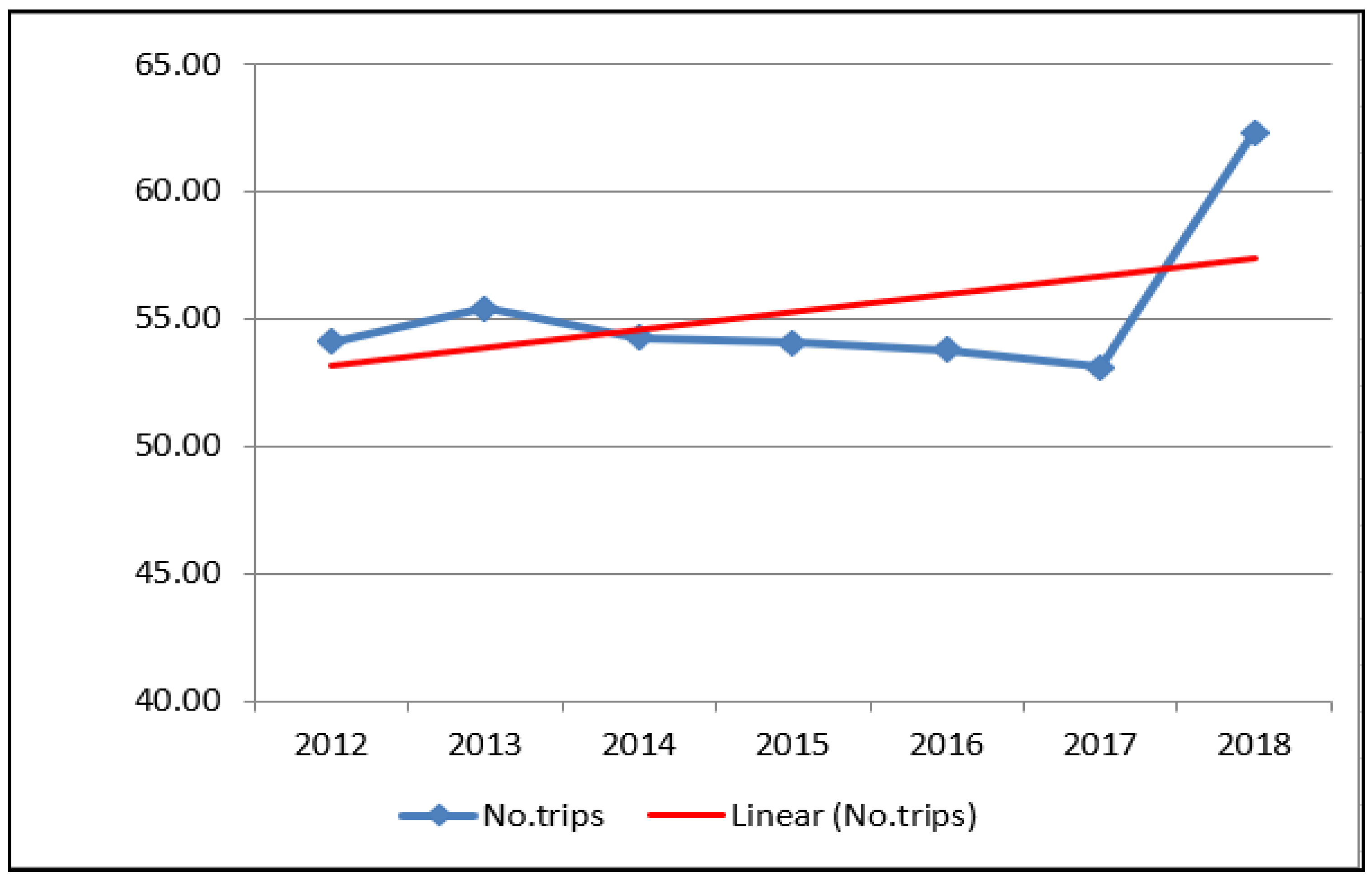
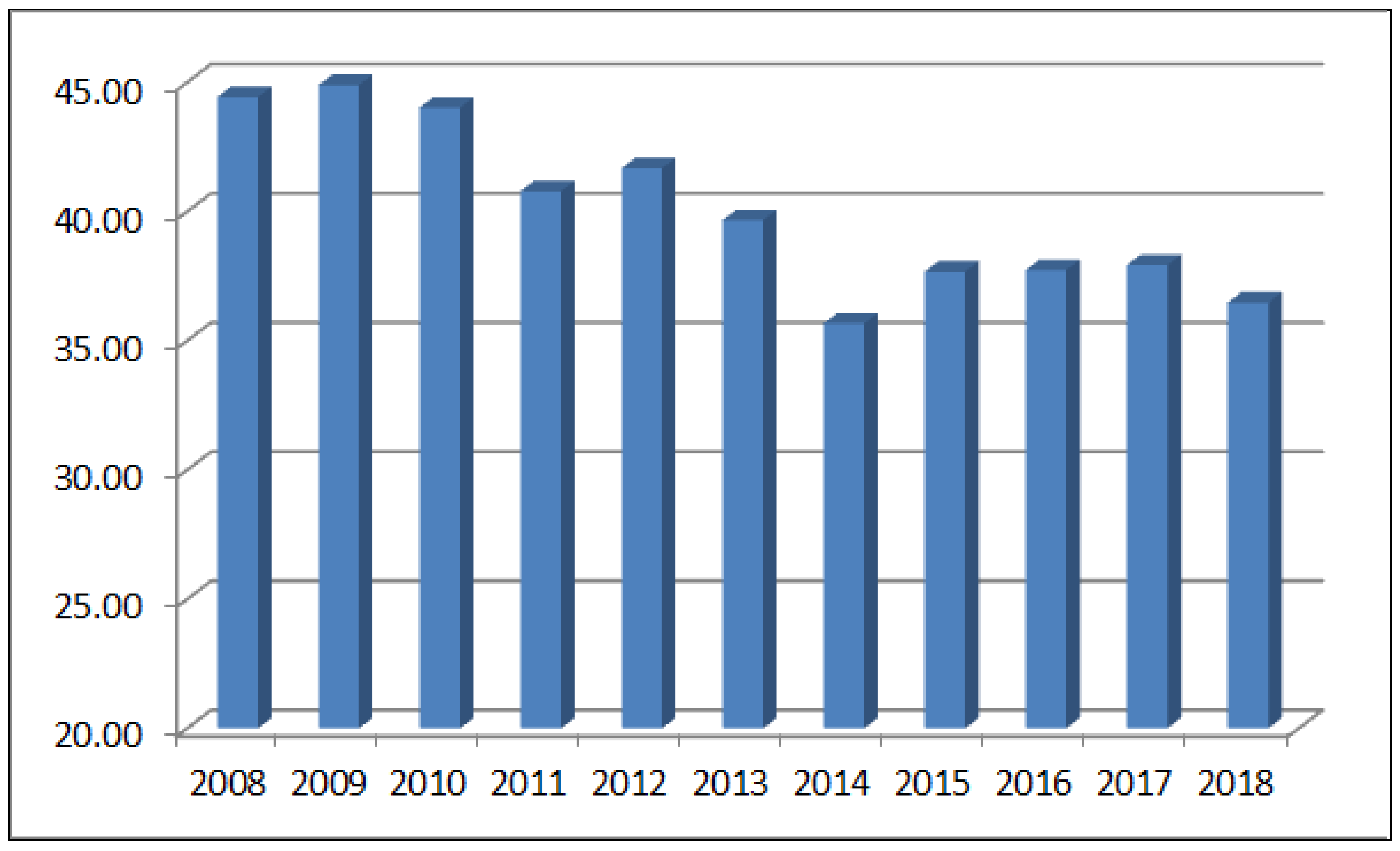
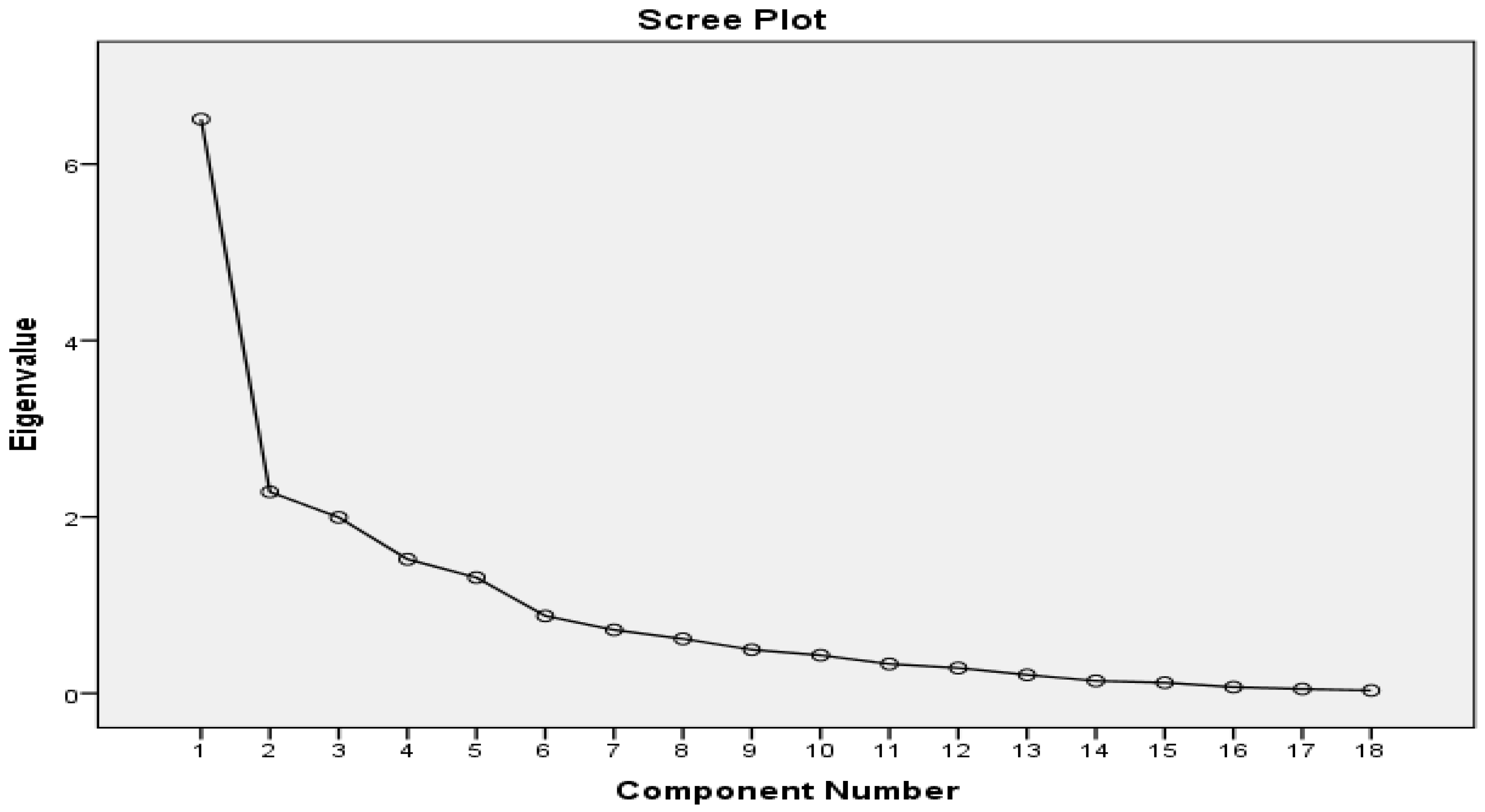
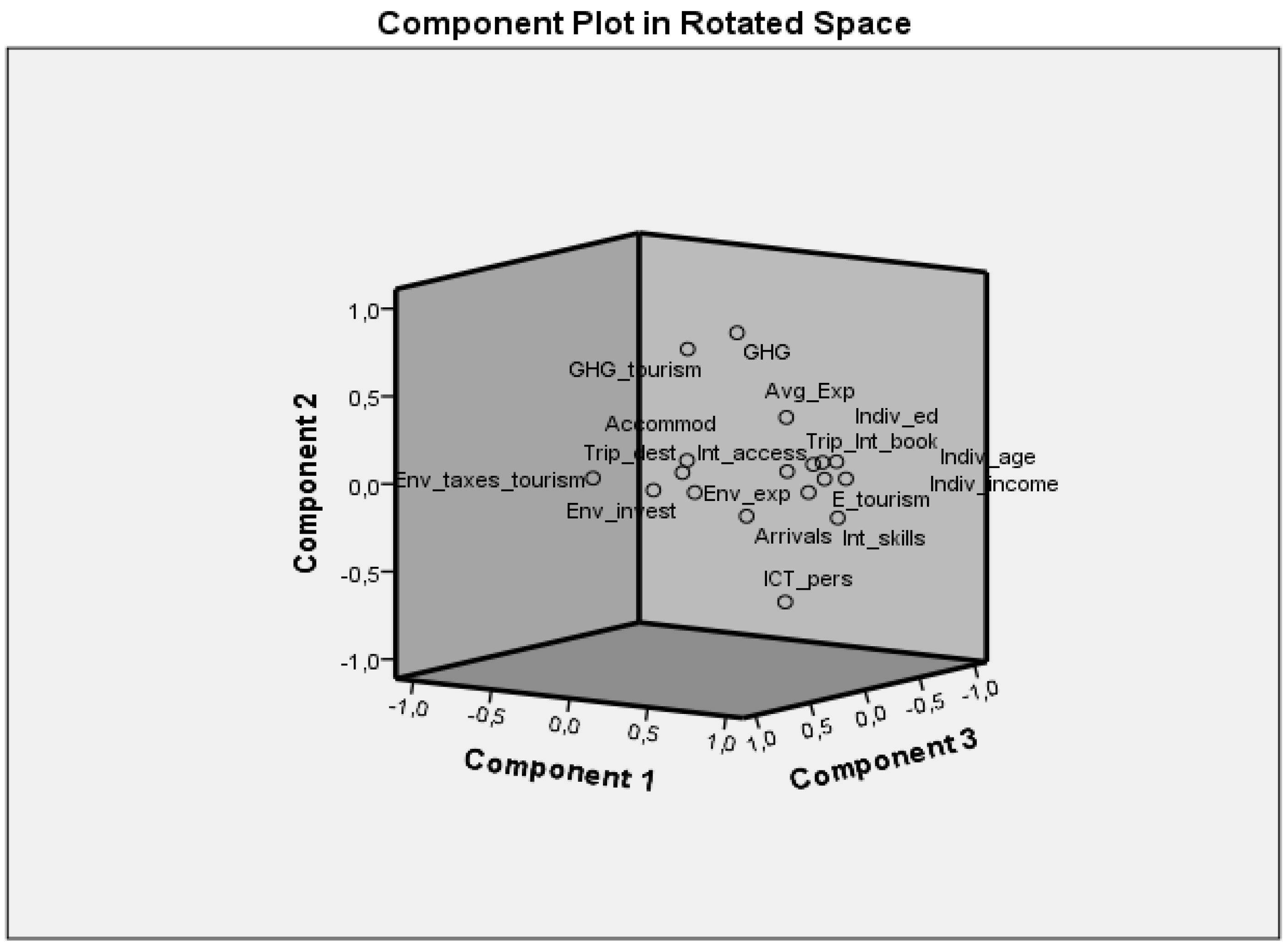
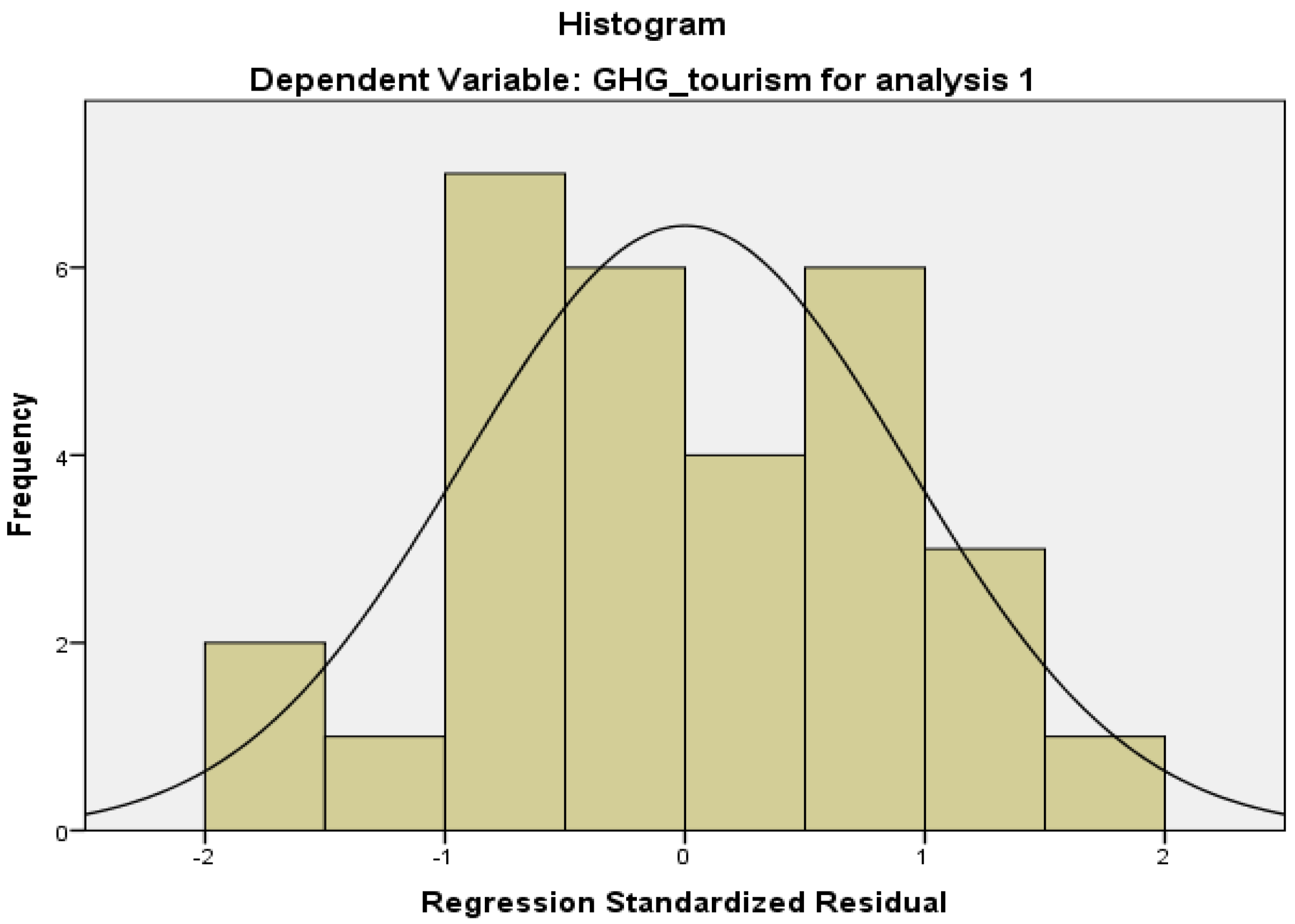
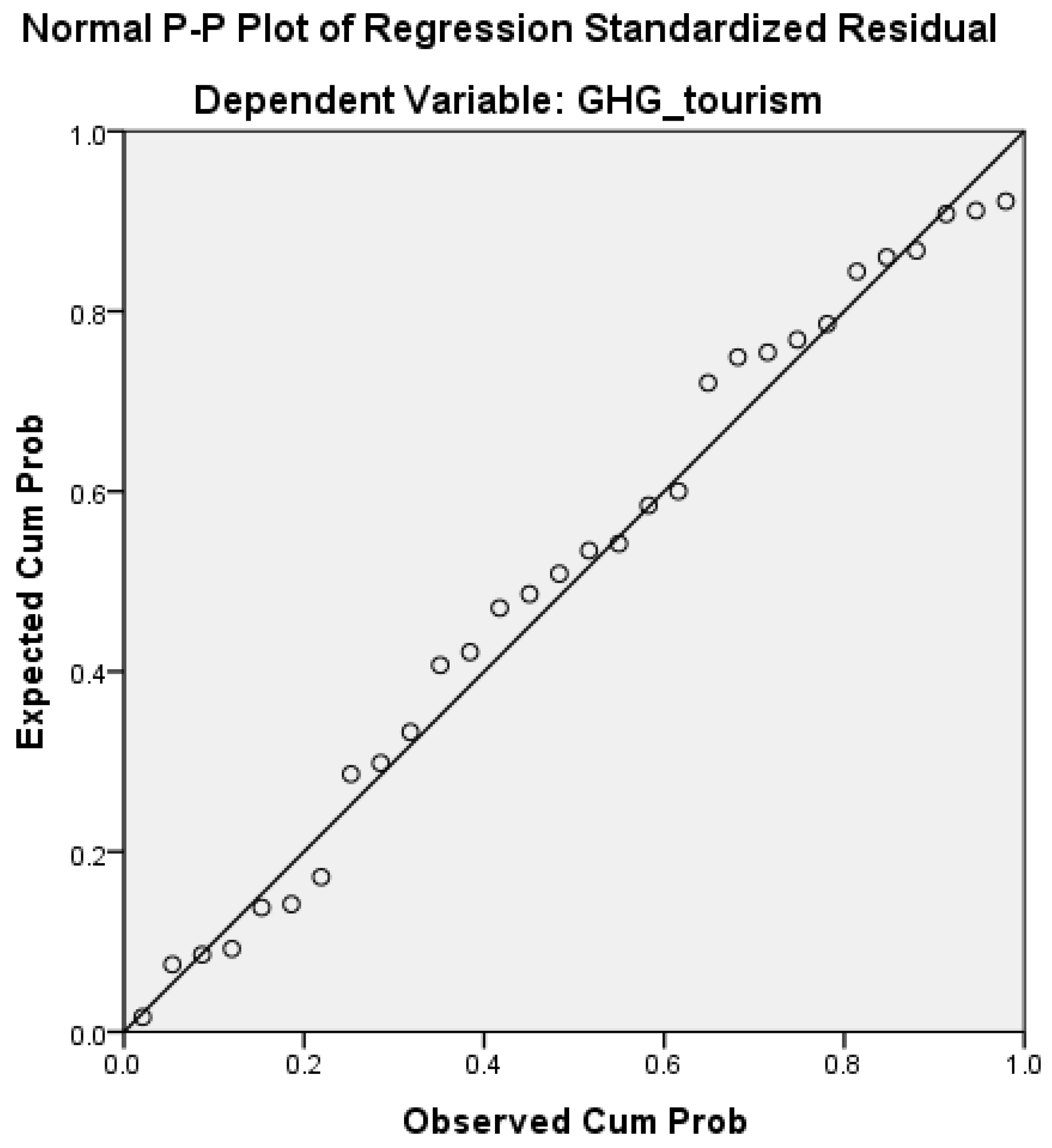
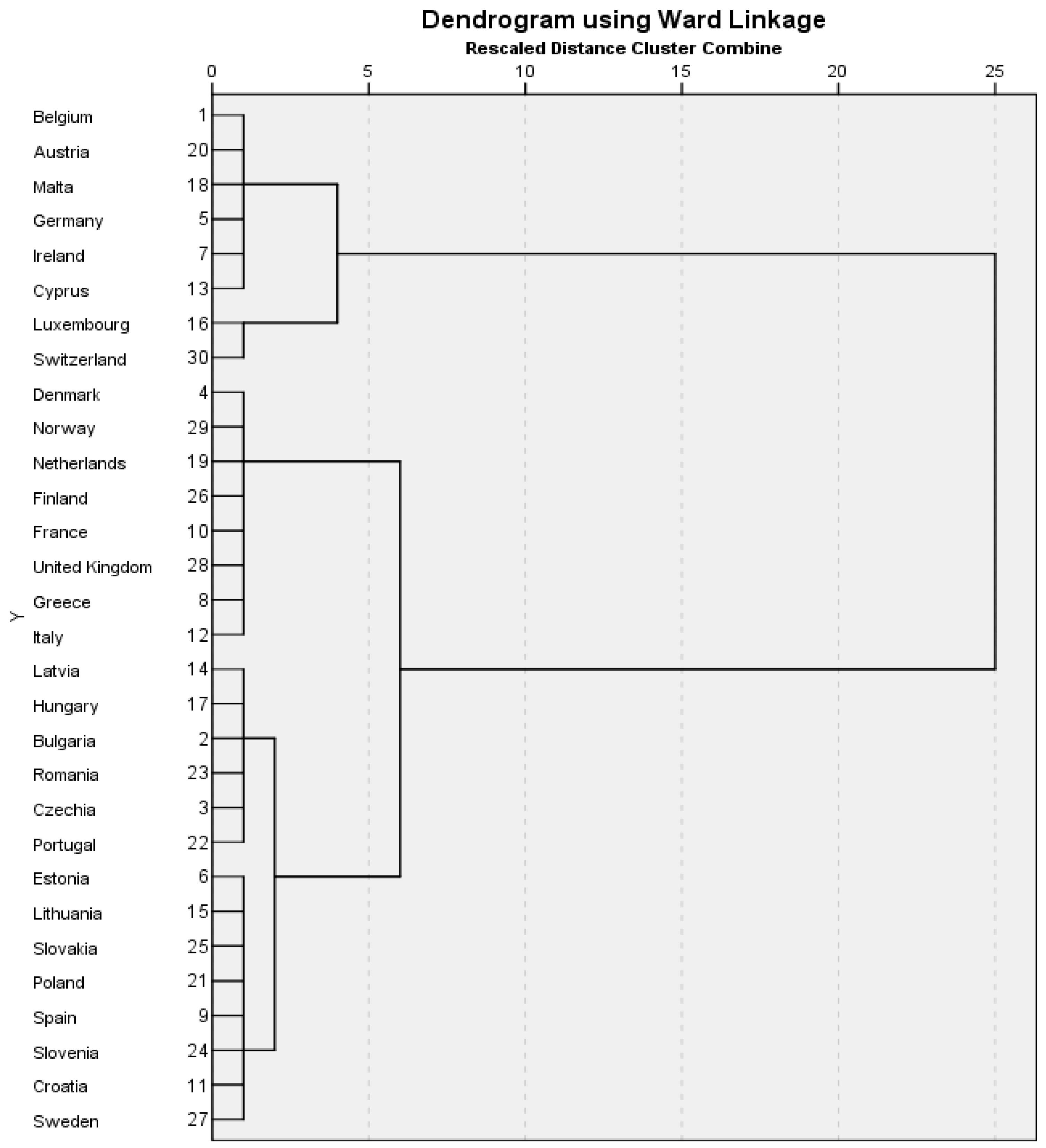
| Domain | Variable Name | Measurement Unit | Label |
|---|---|---|---|
| Tourism | Number of trips, (1 night or over, countryside and mountain), (% of total number of trips) | % | Trip_dest |
| Number of trips in rented green accommodation establishments (campsites, caravan or trailer parks) (% of total number of trips) | % | Accommod | |
| Number of trips with Internet booking of the main means of transport and accommodation (% of total number of trips) | % | Trip_Int_ book | |
| Average expenditure per trip (1 night or over) | EUR | Avg_Exp | |
| Number of arrivals at green tourism accommodation establishments (campsites, caravan or trailer parks) (% of total number of arrivals) | % | Arrivals | |
| ICT | Percentage of the ICT personnel in total employment | % | ICT_pers |
| Percentage of households with Internet access | % | Int_access | |
| Percentage of individuals aged 25–34 using the Internet | % | Indiv_age | |
| Percentage of individuals with high formal education using the Internet | % | Indiv_ed | |
| Percentage of individuals living in a household with income in fourth quartile using the Internet | % | Indiv_ income | |
| Percentage of individuals using the Internet for travel and accommodation services | % | E_tourism | |
| Percentage of individuals who have above basic overall digital skills | % | Int_skills | |
| Environment | Greenhouse gas emissions (GHG), base year 1990 | % | GHG |
| Greenhouse gas emissions in accommodation and food activities (% in total GHG) | % | GHG_ tourism | |
| Environmental protection investments (% of total) | % | Env_invest | |
| National expenditure on environmental protection (% of GDP) | % | Env_exp | |
| Environmental taxes (accommodation and food service activities, % of total) | % | Env_taxes_ tourism | |
| Economic development | GDP at market prices (Percentage of EU28 (2013–2020) total per capita (based on million euro), current prices) | % | GDP |
| Kaiser-Meyer-Olkin Measure of Sampling Adequacy. | 0.617 | |
| Bartlett’s Test of Sphericity | Approx. Chi-Square | 344.001 |
| df | 153 | |
| Sig. | 000 | |
| Component | Initial Eigenvalues | Extraction Sums of Squared Loadings | Rotation Sums of Squared Loadings | ||||||
|---|---|---|---|---|---|---|---|---|---|
| Total | % of Variance | Cumulative % | Total | % of Variance | Cumulative % | Total | % of Variance | Cumulative % | |
| 1 | 6.509 | 36.160 | 36.160 | 6.509 | 36.160 | 36.160 | 6.309 | 35.051 | 35.051 |
| 2 | 2.284 | 12.686 | 48.846 | 2.284 | 12.686 | 48.846 | 2.045 | 11.363 | 46.414 |
| 3 | 1.994 | 11.080 | 59.927 | 1.994 | 11.080 | 59.927 | 1.887 | 10.485 | 56.899 |
| 4 | 1.520 | 8.443 | 68.369 | 1.520 | 8.443 | 68.369 | 1.727 | 9.596 | 66.495 |
| 5 | 1.312 | 7.292 | 75.661 | 1.312 | 7.292 | 75.661 | 1.650 | 9.166 | 75.661 |
| 6 | 0.878 | 4.876 | 80.537 | ||||||
| 7 | 0.718 | 3.992 | 84.529 | ||||||
| 8 | 0.617 | 3.430 | 87.959 | ||||||
| 9 | 0.495 | 2.748 | 90.707 | ||||||
| 10 | 0.432 | 2.397 | 93.105 | ||||||
| 11 | 0.332 | 1.846 | 94.950 | ||||||
| 12 | 0.287 | 1.597 | 96.548 | ||||||
| 13 | 0.209 | 1.161 | 97.708 | ||||||
| 14 | 0.141 | 0.784 | 98.492 | ||||||
| 15 | 0.121 | 0.669 | 99.162 | ||||||
| 16 | 0.070 | 0.391 | 99.552 | ||||||
| 17 | 0.049 | 0.271 | 99.823 | ||||||
| 18 | 0.032 | 0.177 | 100.000 | ||||||
| Component | |||||
|---|---|---|---|---|---|
| 1 | 2 | 3 | 4 | 5 | |
| Trip_Int_book | 0.774 | 0.134 | 0.229 | −0.368 | −0.074 |
| Avg_Exp | 0.708 | 0.423 | 0.141 | −0.374 | −0.009 |
| Int_access | 0.868 | 0.016 | 0.168 | 0.240 | 0.152 |
| Indiv_age | 0.642 | 0.085 | −0.411 | 0.196 | 0.206 |
| Indiv_ed | 0.712 | 0.121 | −0.182 | 0.217 | 0.014 |
| Indiv_income | 0.663 | −0.019 | −0.467 | 0.337 | 0.183 |
| E_tourism | 0.918 | 0.087 | 0.094 | 0.148 | 0.082 |
| Int_skills | 0.924 | −0.151 | −0.020 | 0.126 | −0.065 |
| GDP | 0.850 | 0.164 | 0.099 | 0.041 | −0.204 |
| ICT_pers | 0.592 | −0.664 | −0.013 | −0.024 | −0.019 |
| GHG | 0.227 | 0.824 | −0.095 | −0.055 | −0.114 |
| GHG_tourism | 0.132 | 0.767 | 0.221 | 0.071 | 0.013 |
| Env_invest | 0.227 | 0.036 | 0.669 | 0.347 | 0.323 |
| Env_taxes_tourism | 0.003 | 0.115 | 0.901 | 0.076 | −0.038 |
| Accommod | 0.048 | 0.107 | 0.106 | 0.792 | 0.027 |
| Arrivals | 0.445 | −0.168 | 0.129 | 0.626 | −0.026 |
| Trip_dest | −0.058 | 0.010 | −0.004 | 0.045 | 0.840 |
| Env_exp | 0.056 | −0.084 | 0.048 | −0.018 | 0.816 |
| Component 1 Tourism & Digitalization | Trip_Int_book |
| Avg_Exp | |
| Int_access | |
| Indiv_age | |
| Indiv_ed | |
| Indiv_income | |
| E_tourism | |
| Int_skills | |
| GDP | |
| Component 2 Tourism Pollution | ICT_pers |
| GHG | |
| GHG_tourism | |
| Component 3 Environment Protection | Env_invest |
| Env_taxes_tourism | |
| Component 4 Green Tourism | Accommod |
| Arrivals |
| Model | Unstandardized Coefficients | Standardized Coefficients | t | Sig. | 95.0% Confidence Interval for B | Collinearity Statistics | ||||
|---|---|---|---|---|---|---|---|---|---|---|
| B | Std. Error | Beta | Lower Bound | Upper Bound | Tolerance | VIF | ||||
| 1 | (Constant) | 35.457 | 15.239 | 2.327 | 0.028 | 4.133 | 66.781 | |||
| Arrivals | −2.072 | 0.522 | −0.490 | −3.971 | 0.001 | −3.145 | −1.000 | 0.306 | 3.263 | |
| E_tourism | 0.582 | 0.273 | 0.280 | 2.130 | 0.043 | 0.020 | 1.144 | 0.271 | 3.690 | |
| GDP | 0.126 | 0.048 | 0.257 | 2.626 | 0.014 | 0.027 | 0.224 | 0.486 | 2.058 | |
| Cluster | Composition (Countries) |
|---|---|
| 1 | Belgium, Austria, Malta, Germany, Ireland, Cyprus |
| 2 | Denmark, Norway, Netherlands, Finland, France, United Kingdom, Greece, Italy |
| 3 | Latvia, Hungary, Bulgaria, Romania, Czech Republic, Portugal |
| 4 | Estonia, Lithuania, Slovakia, Poland, Spain, Slovenia, Croatia, Sweden |
| COMPONENT 1—Tourism & Digitalization | |||||||||||
|---|---|---|---|---|---|---|---|---|---|---|---|
| Trip_ Int_Book | Avg_ Exp | Int_ Access | Indiv_ Age | Indiv_ Ed | Indiv_ Income | E_Tourism | Int_ Skills | GDP | |||
| Cluster 1 | 76.86 | 569.62 | 88.17 | 97.50 | 97.67 | 94.83 | 44.67 | 31.7 | 127.38 | ||
| Cluster 2 | 51.40 | 370.95 | 90.63 | 97.25 | 97.63 | 94.25 | 48.25 | 38.5 | 131.84 | ||
| Cluster 3 | 19.63 | 140.44 | 80.50 | 94.67 | 95.50 | 90.50 | 22.67 | 21.50 | 44.77 | ||
| Cluster 4 | 37.29 | 236.28 | 85.13 | 96.88 | 95.50 | 95.38 | 34.25 | 31.25 | 69.03 | ||
| Overall Average | 46.29 | 329.32 | 86.10 | 96.57 | 96.57 | 93.74 | 37.46 | 30.79 | 93.25 | ||
| COMPONENT 2 Tourism Pollution | COMPONENT 3 Environment Protection | COMPONENT 4 Green Tourism | |||||||||
| ICT_Pers | GHG | GHG_ Tourism | Env_ Invest | Env_Taxes _Tourism | Accommod | Arrivals | |||||
| Cluster 1 | 2.98 | 103.22 | 0.66 | 4.91 | 2.58 | 4.77 | 2.80 | ||||
| Cluster 2 | 3.15 | 82.98 | 0.59 | 6.13 | 8.26 | 5.61 | 11.59 | ||||
| Cluster 3 | 2.99 | 66.92 | 0.42 | 0.90 | 0.50 | 6.14 | 3.57 | ||||
| Cluster 4 | 3.12 | 75.48 | 0.35 | 1.54 | 1.58 | 4.15 | 7.20 | ||||
| Overall Average | 3.06 | 82.15 | 0.50 | 3.37 | 3.23 | 5.17 | 6.29 | ||||
| Legend: | |||||||||||
| the most favorable level | |||||||||||
| the most unfavorable level | |||||||||||
Publisher’s Note: MDPI stays neutral with regard to jurisdictional claims in published maps and institutional affiliations. |
© 2020 by the authors. Licensee MDPI, Basel, Switzerland. This article is an open access article distributed under the terms and conditions of the Creative Commons Attribution (CC BY) license (http://creativecommons.org/licenses/by/4.0/).
Share and Cite
Saseanu, A.S.; Ghita, S.I.; Albastroiu, I.; Stoian, C.-A. Aspects of Digitalization and Related Impact on Green Tourism in European Countries. Information 2020, 11, 507. https://doi.org/10.3390/info11110507
Saseanu AS, Ghita SI, Albastroiu I, Stoian C-A. Aspects of Digitalization and Related Impact on Green Tourism in European Countries. Information. 2020; 11(11):507. https://doi.org/10.3390/info11110507
Chicago/Turabian StyleSaseanu, Andreea Simona, Simona Ioana Ghita, Irina Albastroiu, and Carmen-Alexandra Stoian. 2020. "Aspects of Digitalization and Related Impact on Green Tourism in European Countries" Information 11, no. 11: 507. https://doi.org/10.3390/info11110507






